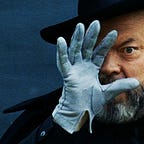America Kills Its Children: The Intersections of Psycho and Easy Rider.
Psycho (1960), the film that ushered in the 1960s, and Easy Rider (1969), the film that turned the lights out on it, might as well be millennia apart in most direct aspects: stylistically, narratively, socially, and politically. Both films seem to be made in completely different and inverted Americas (Psycho in an America still in the grips of 1950s conservatism and paranoia, Easy Rider in an America in the midst of a countercultural upheaval and a drug infused social and sexual revolution). They do however, share key attributes that closely link them together in several profound aspects.
Both films start with the protagonists making a calculated (or miscalculated?) risk, shortchanging their respective systems and coming out of it with a huge sum of money that leaves them on the run. Both acts trigger an escape into a dusty “western” landscape that seems to swallow them.
In both films the main characters perpetrate acts of defiance that disrupt the order of their respective worlds. Marion from Psycho throws away her job, reputation, and social life and gives in to a split-second window of temptation, while simultaneously stealing from the hand of authority that feeds her. Wyatt and Billy on the other hand, discard time with the symbolic act of throwing away their watch, before embarking on their journey and venturing defiantly into a society that goes against everything they represent.
Both acts of rebellion, however, do not go unpunished. It is as if the disruption of the norm that is perpetuated by these acts has vexed the gods that exercise their invisible grasp over their worlds. But what kind of gods are we talking about here? What are the forces that clamped down on our protagonists and restored the order of their respective worlds?
Billy and Wyatt’s trip through the Southern states represents a direct threat to the powers of the regressive, patriarchal social order. They have pushed their luck and squeezed through several tight situations and encounters with figures of authority that are foaming at the mouth at the prospect of their destruction. They are ultimately shot down by rednecks, their bikes swallowed by flames. The paternal figure of authority (the angry volcanic desert god) striking down his rebellious sons with fire.
In Marion’s case, it is a deep force of anti-Oedipal sexual repression that evolves into murderous psychosis. Norman, having killed his mother (anti-Oedipal act), incorporates her into his character and effectively becomes her. He then proceeds to reverse the anti-Oedipal act by having his mother’s image within him kill the rebellious “daughter”, represented by Marion, thus restoring the order disrupted by Marion’s rebellious act, after which he is completely integrated within his mother’s character. The implication being that Norman is a sort of empty shell manipulated by the matriarchal ghost of the mother into acting out its will.
Marion is ultimately swallowed into an artificial hole (the drain) and later into a natural hole (the swamp) along with her car and the money inside it, which is eliminated as a factor in the whole equation. Similarly, the money in Easy Rider plays no role in our characters’ demise, as if to say that once we are in the grip of the primal forces of (human) nature, all worldly values lose their power.
Marion by water, Billy and Wyatt by fire. Marion by the mother, Billy and Wyatt by the father. In some sort of reverse Oedipal counterrevolutionary act, the mother kills the daughter and the father kills the sons in their cribs in order to restore the order of things disrupted by the two acts of revolution perpetrated by our heroes.
If Marion, Wyatt, and Billy are proverbial siblings, we would assume that Marion is the older sister blooming in post-war 50s America, in the shadow of McCarthyism, cold war nuclear fear, and paranoia. Basically in one of the darkest eras in US history in terms of personal freedoms and any form of thinking outside the box. Marion’s act of rebellion is thus a desperate gasp for breath from the suffocation of that era.
Her younger brothers watch on in horror as her rebellion is quelled, the violence in this case an indicator of how fiercely unforgiving “nature” is towards those who attempt to escape it. Marion’s death leaves a bitter taste in their mouths and is a defining factor in their later journey (not unlike the suicide of Peter Fonda’s mother which figures into Easy Rider during the acid trip).
The fictional killing of these two generations that bookended 1960s America would find its counterparts in real life. Easy Rider was an ominous foreshadowing of the disintegration of the counterculture movement in America, whether at the hands of infiltrators from without (conservative elements in American politics and society), or from extreme and implosive elements from within that went too far in the enactment of their delirium. It is not too far fetched to see Norman Bates as some twisted fictional kernel of Charles Manson’s later real life transgressions, a major factor in the hastening of the implosion of the American counterculture. Similarly, a character like Manson would fit perfectly within the “freak” world of Easy Rider, someone the boys might have met on their trip. Seen in that light, the fate of the free-wheelin’ sixties had been sealed before it had even begun.
